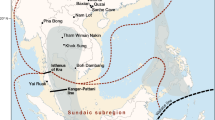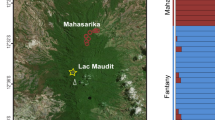Abstract
The hypothesis that Euroamerican settlement displaced some populations of large mammal taxa from lowland plains habitats to previously unoccupied highland mountain habitats was commonly believed in the late nineteenth and early twentieth centuries. By the middle twentieth century biologists had come to favor the hypothesis that Euroamerican colonization resulted in the extirpation of populations of large mammal in lowland habitats and those taxa survived in pre-existing relict populations in the highlands. Why modern biologists changed their minds is unclear. There is no historical evidence that unequivocally favors one hypothesis over the other. The low-elevation Columbia Basin of eastern Washington state in the northwestern United States is surrounded by forested mountains. The majority of historical records (1850 AD or younger) of black bear (Ursus americanus), brown bear (Ursus arctos), and North American elk (Cervus elaphus) occur in mountainous, coniferous forest habitats. Paleozoological records of these taxa ≤ 10,000 year old and >160 year old in both highland and lowland habitats suggest the displacement hypothesis does not apply to ursids and elk in this area. These taxa seem to have been more or less ubiquitous in the area prior to Euroamerican colonization (ca. 1850 AD), and were extirpated from lowland habitats after colonization. Recent colonization of lowland shrub-steppe habitats by elk in particular, although historically unprecedented, must be categorized as recolonization rather than an invasion. Whether a species is classified as indigenous or nonindigenous may influence management activities focused on that species. The paleozoological record indicates ursids and elk are indigenous to the highland forest habitats of eastern Washington.


Similar content being viewed by others
References
Ames KM, Dumond DE, Galm JR, Minor R (1998) Prehistory of the southern Plateau. In: Walker DE (ed) Handbook of North American Indians, vol 12. Plateau. Smithsonian Institution, Washington, pp 103–119
Armstrong DM (1972) Distribution of mammals in Colorado, monograph of the museum of natural history, 3rd edn. University of Kansas, Lawrence
Bailey V (1931) Mammals of New Mexico. North American Fauna no. 53
Booth ES (1947) Systematic review of the land mammals of Washington. Unpublished PhD dissertation, State College of Washington, Washington State University, Pullman
Bryant LD, Maser C (1982) Classification and distribution. In: Thomas JW, Toweill DE (eds) Elk of North America: ecology and management. Stackpole, Harrisburg, Pennsylvania, pp 1–59
Buechner HK (1960) The bighorn sheep in the United States, its past, present, and future. Wildlife Monographs no. 4
Couch LK (1935) Chronological data on elk introduction into Oregon and Washington. Murrelet 16:3–6, 42
Dalquest WW (1948) Mammals of Washington. University of Kansas, Museum of Natural History Publication no. 2, Lawrence
Daubenmire R (1970) Steppe vegetation of Washington. Washington agricultural experiment station technical bulletin 62. Washington State University, Pullman
Dice LR (1919) The mammals of southeastern Washington. Journal of Mammalogy 1:10–22
Donlan CJ, Martin PS (2004) Role of ecological history in invasive species management and conservation. Conservation Biology 18:267–269
Dryden C (1968) Dryden’s history of Washington. Binfords & Mort, Portland, Oregon
Edson J (1916) Wild animals of Mount Baker. Mountaineer 9:51–57
Elliot DG (1899) Catalogue of mammals from the Olympic Peninsula, Washington, with descriptions of new species. Columbia Field Museum Publication no. 32, Zool Series 1:241–276
Franklin JF, Dyrness CT (1973) Natural vegetation of Oregon and Washington. USDA Forest Service, Pacific Northwest Forest and Range Experiment Station, GTR PNW-8, Portland, Oregon
Fryxell FM (1926) A new high altitude limit for the American bison. Journal of Mammalogy 7:102–109
Graham RW, Lundelius ER, Jr (1994) Faunmap: a database documenting late Quaternary distributions of mammal species in the United States. Illinois State Museum Scientific Papers 25, Springfield
Graves HS (1917) National forests and national parks in wild-life conservation. In: Proceedings of the fourth national parks conference. Government Printing Office, Washington, DC, pp 187–192
Grayson DK (1981) A critical view of the use of vertebrates in paleoenvironmental reconstruction. Journal of Ethnobiology 1:28–38
Grayson DK (1984) Quantitative zooarchaeology: topics in the analysis of archaeological faunas. Academic Press, New York
Grayson DK (2001) The archaeological record of human impacts on animal populations. Journal of World Prehistory 15:1–68
Grayson DK, Meltzer DJ (2002) Clovis hunting and large mammal extinction: a critical review of the evidence. Journal of World Prehistory 16:313–359
Grimm RL (1939) Northern Yellowstone winter range studies. Journal of Wildlife Management 3:295–306
Grinnell GB (1894) (untitled footnote). Forest and Stream 42(15):312
Grinnell GB (1928) Mountain sheep. Journal of Mammalogy 9:1–9
Hall FS (1932) A historical resume of exploration and survey—mammal types and their collectors in the state of Washington. Murrelet 13:63–91
Hoffmann RS, Pattie DL (1968) A guide to Montana mammals: identification habitat distribution and abundance. University of Montana, Missoula
Huntington DW (1904) Our big game. Charles Scribner’s Sons, New York
Ingles LG (1965) Mammals of the Pacific states: California, Oregon. Washington. Stanford University Press, Stanford, California
Irwin LL (2002) Migration. In: Toweill DE, Thomas JW (eds) North American elk: ecology and management. Smithsonian Institution Press, Washington, pp 493–513
Johnson RE, Cassidy KM (1997) Terrestrial mammals of Washington state: location data and predicted distributions. In: Cassidy KM, Grue CE, Smith MR, Dvornich KM (eds) Washington state gap analysis—final report, vol 3. Washington Cooperative Fish and Wildlife Research Unit, University of Washington, Seattle
Kay CE (1990) Yellowstone Northern elk herd: a critical evaluation of the natural regulation paradigm. Unpublished PhD dissertation, Utah State University, Logan
Kay CE (1994) Aboriginal overkill: the role of Native Americans in structuring western ecosystems. Human Nature 5:359–398
Larrison EJ (1967) Guide to Idaho mammals. Journal of Idaho Academy of Science 7:1–166
Lodge DM, Shrader-Frechette K (2003) Nonindigenous species: ecological explanation, environmental ethics, and public policy. Conservation Biology 17:31–37
Lodge DM, Shrader-Frechette K (2004) Deep-history perspective on biological invasions: response to Donlan and Martin. Conservation Biology 18:270–271
Lohse ES, Sprague R (1998) History of research. In: Walker DE (ed) Handbook of North American Indians, vol 12. Plateau. Smithsonian Institution, Washington, pp 8–28
Lyman RL (1986) On the Holocene history of Ursus in eastern Washington. Northwest Science 60:67–72
Lyman RL (1994) Vertebrate taphonomy. Cambridge University Press, Cambridge
Lyman RL (2000a) Building cultural chronology in eastern Washington: the influence of geochronology, index fossils, and radiocarbon dating. Geoarchaeology 15:609–648
Lyman RL (2000b) Radiocarbon dating in eastern Washington and in western Washington. Northwest Anthropological Research Notes 34:1–16
Lyman RL (2002) Cultural resource management-driven spatial samples in archaeology: an example from eastern Washington. Journal of Northwest Anthropology 36:51–67
Lyman RL (2004a) Aboriginal overkill in the intermountain west of North America: zooarchaeological tests and implications. Human Nature 15:169–208
Lyman RL (2004b) Prehistoric biogeography, abundance, and phenotypic plasticity of elk (Cervus elaphus) in Washington state. In: Lyman RL, Cannon KP (eds) Zooarchaeology and conservation biology. University of Utah Press, Salt Lake City, pp 136–163
Lyman RL (2006) Paleozoology in the service of conservation biology. Evolutionary Anthropology 15:11–19
Lyman RL (2008a) Estimating the magnitude of data asymmetry in paleozoological biogeography. International Journal of Osteoarchaeology 18:85–94
Lyman RL (2008b) Quantitative paleozoology. Cambridge University Press, Cambridge
Lyman RL (2010a) New record of moose (Alces alces) in southeastern Washington state. Northwest Science 84:98–101
Lyman RL (2010b) Prehistoric anthropogenic impacts to local and regional faunas are not ubiquitous. In: Dean RM (ed) The archaeology of anthropogenic environments. Center for archaeological investigations occasional paper no. 37. Southern Illinois University Press, Carbondale, pp 204–224
Lyman RL, Wolverton S (2002) The late prehistoric/early historic game sink in the northwestern United States. Conservation Biology 16:73–85
Macy PP (1934) Some notes on the animal life of Mount Rainier National Park, Washington. Murrelet 15:46–48
Mann ME (2002) Little ice age. In: MacCracken MC, Perry JS (eds) Encyclopedia of global environmental change, vol 1. The earth system: physical and chemical dimensions of global environmental change. Wiley, Chichester, pp 504–509
Marsh KR (2004) The ups and downs of mountain life: historical patterns of adaptation in the Cascade Mountains. Western Historical Quarterly 35:193–213
Martin PS, Szuter CR (1999) War zones and game sinks in Lewis and Clark’s west. Conservation Biology 13:36–45
McKee B (1972) Cascadia: the geologic evolution of the Pacific Northwest. McGraw-Hill, New York
Meagher MM (1973) The bison of Yellowstone National Park. National Park service scientific monograph series no. 1. Government Printing Office, Washington, DC
Murie A (1940) Ecology of the coyote in the Yellowstone. Fauna of the National Parks of the United States, fauna series no. 4. Government Printing Office, Washington, DC
Murie OJ (1951) The elk of North America. Stackpole, Harrisburg, PA
O’Connor J (1961) The big game animals of North America. EP Dutton and Co, New York
Pasitschniak-Arts M, Messier F (2000) Brown (grizzly) and polar bears. In: Demarais S, Krausman PR (eds) Ecology and management of large mammals in North America. Prentice Hall, Upper Saddle River, NJ, pp 409–428
Peek JM (1982) Elk, Cervus elaphus. In: Chapman JA, Feldhamer GA (eds) Wild mammals of North America: biology management economics. Johns Hopkins University Press, Baltimore, MA, pp 851–861
Pelton MR (2000) Black bear. In: Demarais S, Krausman PR (eds) Ecology and management of large mammals in North America. Prentice Hall, Upper Saddle River, NJ, pp 389–408
Randklev CR, Wolverton S, Lundeen B, Kennedy JH (2010) A paleozoological perspective on Unionid (Mollusca: Unionidae) zoogeography in the Upper Trinity River Basin, Texas. Ecological Applications (in press)
Rickard WH, Hedlund JD, Fitzner RE (1977) Elk in the shrub-steppe region of Washington: an authentic record. Science 196:1009–1010
Rush WM (1932) Northern Yellowstone elk study. Montana Fish and Game Commission, Helena
Schullery P (1997) Searching for Yellowstone: ecology and wonder in the last wilderness. Houghton Mifflin, Boston, Massachusetts
Schullery P, Whittlesey L (1992) The documentary record of wolves and related wildlife species in the Yellowstone National Park area prior to 1882. In: Varley JD, Brewster WG (eds) Wolves for Yellowstone? A report to the United States Congress, vol 4. National Park Service, Yellowstone National Park, pp I-1–I-173
Skinner MP (1927) The predatory and fur-bearing animals of the Yellowstone National Park. Roosevelt Wildlife Bulletin 4(2):1–284
Sutherland WJ, Pullin AS, Dolman PM, Knight TM (2004) The need for evidence-based conservation. Trends in Ecology and Evolution 19:305–308
Taylor WP, Shaw WT (1927) Mammals and birds of Mount Rainier National Park. US Government Printing Office, Washington
Taylor WP, Shaw WT (1929) Provisional list of land mammals of the state of Washington. Occupational Papers Charles R. Conner Museum no. 2. State College of Washington, Washington State University, Pullman
Whittaker RH (1970) Communities and ecosystems. Macmillan, London
Wisdom MJ, Cook JG (2000) North American elk. In: Demarais S, Krausman PR (eds) Ecology and management of large mammals in North America. Prentice Hall, Upper Saddle River, New Jersey, pp 694–735
Zeveloff SI, Collett FR (1988) Mammals of the intermountain west. University of Utah Press, Salt Lake City
Acknowledgments
The lowland-to-highland displacement hypothesis is one that my father, a lifetime resident of southeastern Washington, believed and taught me, especially with respect to the local elk population. Despite his inaccuracy, I miss him and here gratefully acknowledge that had he not taught me what he did, I would not be doing what I do today and having so much fun doing it. Thanks to B. Akersten, C. Randklev, S. Wolverton, and several anonymous reviewers for comments on an early draft.
Author information
Authors and Affiliations
Corresponding author
Rights and permissions
About this article
Cite this article
Lee Lyman, R. Paleozoological Data Suggest Euroamerican Settlement Did Not Displace Ursids and North American Elk from Lowlands to Highlands. Environmental Management 47, 899–906 (2011). https://doi.org/10.1007/s00267-011-9667-7
Received:
Accepted:
Published:
Issue Date:
DOI: https://doi.org/10.1007/s00267-011-9667-7




